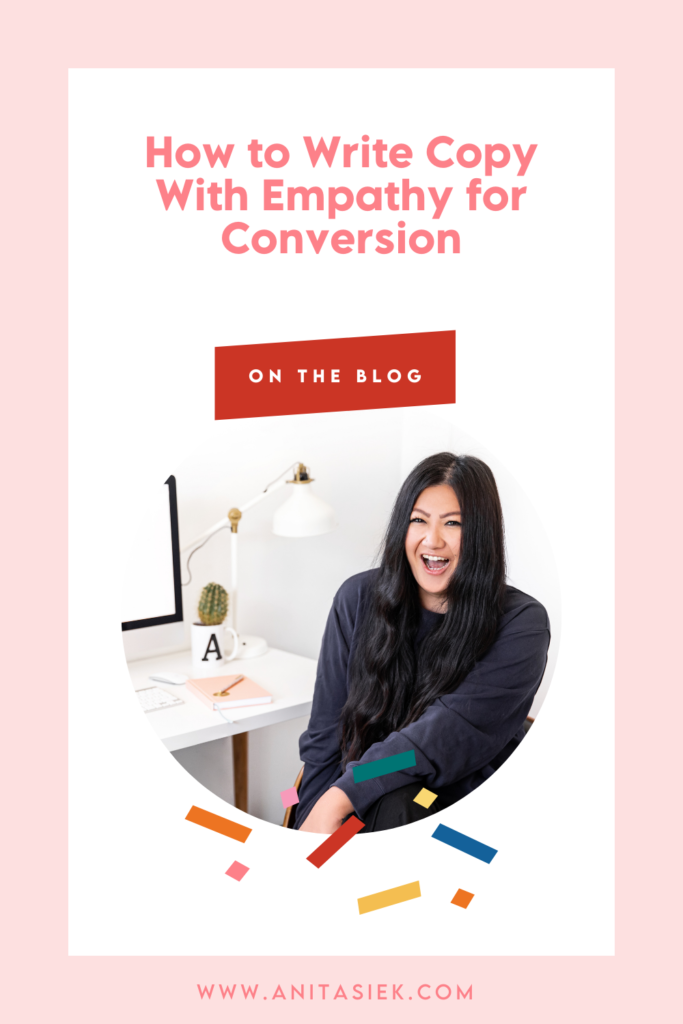The Anita Siek Blog
The Brandfetti Podcast
The Wordfetti
Shop
Podcast
Personal
Content Magic
Business
Lawyer (yep-a-dee-yep, I used to write things people never read) turned Brand and Copy Strategist, and Word-ucator for brands like you, who want to ZIG when others zag.
Hi, I'm Anita!
How to Write Copy With Empathy for Conversion

Photo credits: @mattcrump
Podcast Shownotes (Bullet)
- What questions we should ask ourselves when we work with a client?
- We buy experiences and feelings, not just products or services.
- 95 % of purchasing decisions are made subconsciously, according to Professor Zaltamn from Harvard Business School.
- 1st Tip: Write for humans, not robots.
- 2nd Tip: Understand how your product or service will make your audience feel after they use or engage you.
- 3rd Tip: Use your audience language.
- Bonus Tip: Read your audience’s testimonials, reviews, and forums. Read about how they describe their pain points.
Podcast Shownotes (Timestamps)
00:51 – 01:28: What questions we should ask ourselves when we work with a client?
01:32 – 02:22: We buy experiences and feelings, not just products or services.
02:23 – 04:35: 95 % of purchasing decisions are made subconsciously, according to Professor Zaltamn from Harvard Business School.
04:51 – 06:35: 1st Tip: Write for humans, not robots.
06:37 – 09:27: 2nd Tip: Understand how your product or service will make your audience feel after they use or engage you.
09:30 – 11:50: 3rd Tip: Use your audience language.
11:01 – 12:23: Bonus Tip: Read your audience’s testimonials, reviews, and forums. Read about how they describe their pain points.

“What do we want the audience to feel?”
That’s always the first question we ask when writing copy, whether it’s for Wordfetti or one of our VIP clients.
Because that’s the people we are actually writing for.
Why the emphasis on how they feel? Because so many of our buying decisions come from a place of emotion.
If you think about it, as humans we buy experiences and a feeling, not just a product or a service.
We don’t buy a mattress we buy a good night’s sleep.
We don’t buy a GHD hot iron, we buy the sleek, and beautiful feeling that a GHD will leave us with when we use it.
And when we have a BMW and a Jeep in front of us, some of us will gravitate towards the BMW or the Toyota because of the emotions we have around that make. Be it about feeling powerful, luxurious or going on an adventure.
I’m not making this up as I go; this has been said by Professor Zaltman from Harvard Business School who mentions that 95% of our purchasing decisions are made subconsciously.
Where I see a lot of brands and businesses fall is when it comes to communicating what they ACTUALLY sell.
The most common mistake is on the sales page, diving straight into the benefits and features of a product or service. Talking about the product specifics, and how it is better, faster and more superior. Explaining how they will have a personalised consumer experience and you might even perhaps walk through figures, proof and statistics to prove your point above.
The problem is, outlining the product specifications or what the service is and everything that’s included, is that unless you are able to make your audience feel that they have to have what you offer, then your efforts are probably going to be wasted.
Consumer copywriters among me probably already know this because it’s what we do. We play on the emotion of feeling and emotion. And it’s brands like Apple that have nailed that to a tee. Where they don’t even focus on the specifications of the Graphics Card or the RAM on an Apple Computer. It’s the feeling of ease. Simplicity.
You need to be able to get to the soul of what motivates your audience to commit to buy. This is where we can choose one over the other despite better alternatives or even cheaper options.
Are you ready to dial up the emotional temperature in your copy? Here are 3 tips for you.

Write for humans. Not robots or search engines.
This is not about me putting down the powers of SEO. SEO fundamentals are KEY to getting organic traffic to a website.
But there is a difference between writing purely for Google Gods, and writing for humans. And one’s keyword density shouldn’t ever take away the quality of your content and the ability to connect with your audience through your copy.
Writing great copy for the web isn’t about focusing on a keyphrase per page, milking it a million times, including a keyword every couple of sentences and sprinkling your keywords left right and centre or heck even in white invisible font.
Remember.
There is a difference between content that is written humanly, in consideration of Google.
And content written for Google, without your reader in mind.

Understand how your product or service will make your audience feel AFTER they use or engage you
Is it confidence? Is it about taking a load off their shoulders or streamlining and helping them gain back time?
Pause and stop thinking about the product features and benefits. And what tangibly they will get out of your service.
How will they FEEL?
It’s not about “OH that’s clever!”. We want “HOLY MOLY. These guys get me. Let’s do this.”
From there? Once you know the feeling to hone into?
Consider what content to create to present to your audience to inspire that feeling so that your audience? Can take action. And your offer becomes not only *chefs kiss* irresistible but will help it resonate with your audience.
For example, let’s say you own a physical store that sells supplements or vitamins. Don’t just focus on the quality of the vitamins or the process. Talk about the value of the vitamins. How they’ll make you feel.
If you are a health food blogger, where a lot of your audiences are mum’s; don’t just share recipes and leave it at that. Put yourself in the shoes of other mums. What are some meals they can cook as an activity with their littles or as a whole family on the weekend? That feeling of joy, fun and bonding.
Make the experience an emotional experience.

Use your audience’s language
Too often, we write copy we write for ourselves as the passionate business owner who could talk about what we do for an inappropriately long time.
What we don’t realise though? Is that our audience may not understand the language we use, and may use language different to us. Don’t use industry lingo. Don’t be too fancy because frankly? Your audience will likely respond to something short and simple, where you echo the way they would speak to their friends and family about your service.
Prime example? A lot of people have no idea what a Brand Strategy is or what a copywriter does.
So what we do at Wordfetti is instead of saying “hi we do brand strategy and we do copywriting”, we say we develop Brand DNA and we craft stand out brands through words and content.
Bonus tip?
If you really want to get to know your audience’s language? Read testimonials, reviews and forums. Read about how they describe their pain points and listen as well, when you talk to them. What frustrates them? What words keep on popping up as they explain your product or service.
We as humans have not changed, our behaviours and fundamentally the same. We are as emotional as ever. Connect to your audience, not through tactics, but empathy.
Want more copywriting goodness delivered straight to your ears? Tune into the Brandfetti podcast
Want to get more copy, brand and content tips? Listen in on Brandfetti and follow me here and the team here.

Check out these popular posts


